Ohio is well-known for its varied plant life, with nut trees being the most naturally abundant type of tree in the state.
Known for their hardiness and tolerance to unwelcoming growing conditions, nut trees have survived for millennia in the state, and some have become synonymous with Ohio itself.
This guide lists 15 of the top nut trees in Ohio. Some you can grow, while others offer many foraging opportunities.
1. Ohio Buckeye
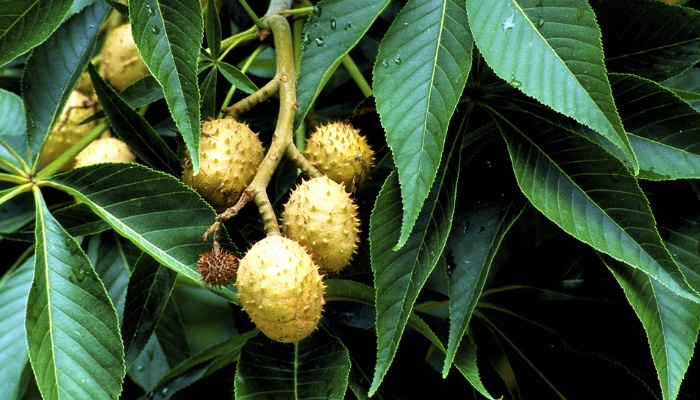
The Ohio buckeye is a very popular tree in the state of Ohio with dense, lush, green foliage that reaches the ground. In the spring, red and yellow flowers bloom on the tree. The leaves and twigs produce a bad smell when crushed.
The nuts are brown, are 2 inches in diameter, and contain tannic acid making them toxic for both humans and cattle if eaten without being properly leached first.
- Mature size: 50-60 feet
- Key identifying features: Each leaf has 5 leaflets, twigs emit foul smell when crushed
- Years to reach maturity: 60-80 years
- Grow Zones: 3 to 7
2. Yellow Buckeye

This is another tree native to the Ohio Valley. It has less dense foliage than the Ohio buckeye with leaves that are light green.
The blooms are either yellow or yellow-green. The fruits are 3 inches in diameter with a smooth brown surface. They’re toxic to humans but when cured with a leaching process, they become edible.
- Mature size: 60–75 feet
- Key identifying features: Winter buds are covered with smooth scales, doesn’t have foul odor when crushed
- Years to reach maturity: 60-80 years
- Grow Zones: 4 to 8
3. Black Walnut

Known for its dark wood, this tree has a spicy odor and gray-black bark. The tree starts producing nuts 4 to 6 years after planting although the yield varies every year. The nuts ripen and drop in October.
- Mature size: 70-80 feet
- Key identifying features: Dark, heavily ridged bark, toothed leaves
- Years to reach maturity: 12-15 years
- Grow Zones: 4 to 9
4. Butternut
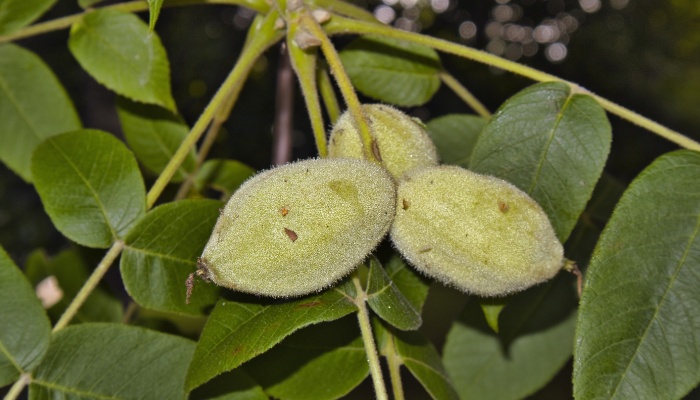
Butternut is a slow-growing tree that can live up to 75 years. The leaves are downy with a bright yellow-green color.
The tree flowers in the spring, and a lemon-shaped nut develops after pollination. The oblong nut is 2 inches long and 1 inch wide. Nuts ripen in the fall.
- Mature size: 40-60 feet
- Key identifying features: Mature pale-gray bark, sharply ridged nuts
- Years to reach maturity: 20 years
- Grow Zones: 2 to 3
5. American Chestnut

The American chestnut is a deciduous hardwood tree with a long, slender trunk and a lush canopy that starts far from the ground.
The tree produces clusters of small, pale green flowers in the spring. The pollen causes allergy attacks in some people.
The tree starts producing nuts about 8 to 10 years after planting, and the nuts ripen and fall in October or around the time of the first frost.
- Mature size: 100 feet
- Key identifying features: Oval leaves with toothed edges and red-brown, ridged bark
- Years to reach maturity: 15-20 years
- Grow Zones: 4 to 8
6. Chinese Chestnut
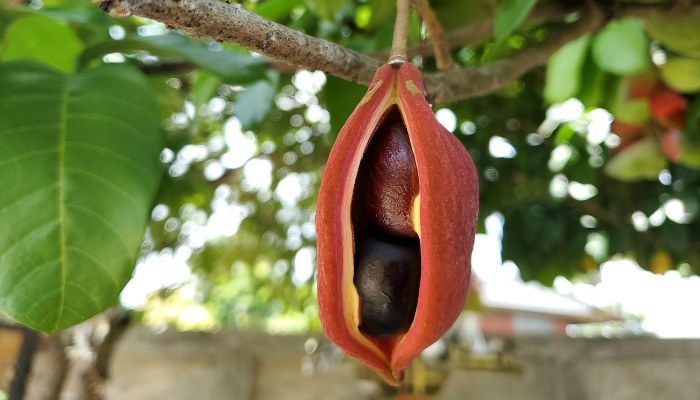
The Chinese chestnut is a tall tree with a broad crown and long leaves with toothed edges.
The nuts are brown and glossy measuring about 1 inch in diameter. They have a sweet taste and are packed with flavors.
- Mature size: 40-60 feet
- Key identifying features: Large spreading canopy with good shade and sweet nuts
- Years to reach maturity: 4-5 years
- Grow Zones: 4 to 8
7. Horse Chestnut

This tall tree has a domed crown and large branches. The bark is pink-gray but turns dark brown as the tree matures.
The flowers bloom in the spring in white colors and blotches of pink. The nuts are called conkers, each about 1.5 inches in diameter. They’re brown with white scars at the base.
- Mature size: 50-75 feet
- Key identifying features: Smooth pink-gray bark when young that turns dark and scaly as it matures
- Years to reach maturity: 15-20 years
- Grow Zones: 3 to 8
8. Hazelnut

The hazelnut is a bush-like tree with branches growing near the ground. Hazelnuts are a good substitute for coffee.
The nuts take about 8 months to mature. When they’re ripe, they fall out of the tree. The nuts are eaten raw or roasted and go into many desserts such as ice cream.
- Mature size: 15-18 feet
- Key identifying features: Gray-brown and smooth bark with hairy stems and oval leaf buds
- Years to reach maturity: 8 years
- Grow Zones: 4 to 9
9. Hican
A hybrid of the pecan and hickory, the hican has the good flavors of hickory with the smooth texture of the pecan.
Most hybrids occur naturally, but the results are not always satisfying with some trees not producing nuts at all.
- Mature size: 60-80 feet
- Key identifying features: Hardy with early ripening nuts, sterile
- Years to reach maturity: 15 years
- Grow Zones: 5 to 8
10. Shellbark Hickory
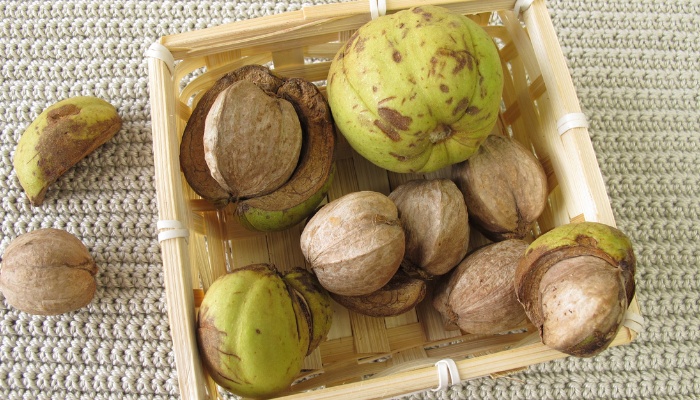
The crown of the shellbark hickory is narrow and oblong, and it rises atop a long and slender trunk. The bark is fissured when the tree matures.
It takes the tree about 10 to 12 years to produce large, sweet nuts. Besides their delicious nuts, the trees are grown for their ornamental value.
- Mature size: 80 feet
- Key identifying features: Short limbs, narrow crown, and shaggy bark
- Years to reach maturity: 10-12 years
- Grow Zones: 5 to 8
11. Shagbark Hickory
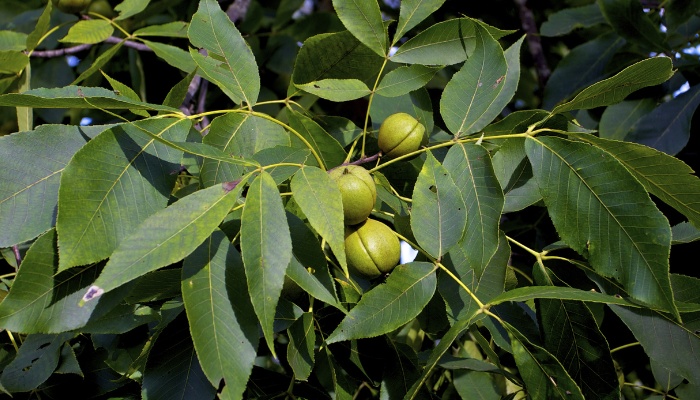
As the name implies, the bark of this tree peels off and sticks out of the trunk like wild hair.
These tall trees can live up to 350 years in the wild. The fruits are about 1 inch long and have rich flavors and a sweet taste.
They’re the main food source for a wide variety of animals including chipmunks and red foxes.
- Mature size: 60-80 feet
- Key identifying features: Shaggy bark that peels off in long strips, golden-yellow fall color
- Years to reach maturity: 40 years
- Grow Zones: 4 to 8
12. Pignut Hickory

The pignut hickory is a slow-growing tree that takes time to mature and produce fruits. Fruiting usually starts around age 30, but some trees could delay that until they reach 300 years old.
Like shagbark hickory, these nuts attract an array of wildlife including various species of squirrels along with turkey and songbirds.
The nuts are very nutritious with high levels of fat, protein, calcium, and phosphorus.
- Mature size: 50-80 feet
- Key identifying features: 3 to 5 leaflets, lacey design in the bark, and small buds
- Years to reach maturity: 75 years
- Grow Zones: 5 to 9
13. Oak
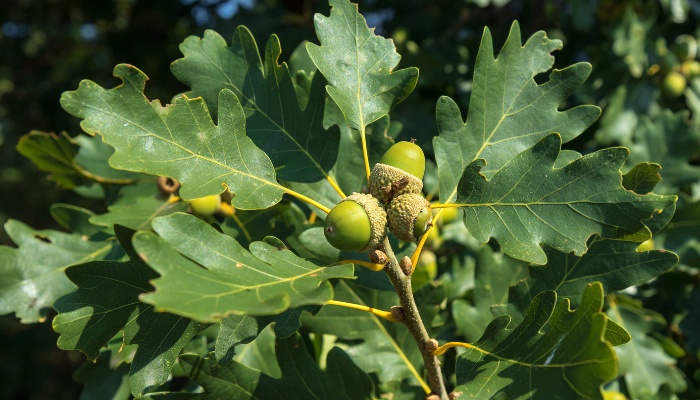
The mighty evergreen oak can be a shrub or a tree. Oak trees are members of the beech family, and there are well over 50 oak species to choose from.
The lobed leaves can have serrated edges, or they can be smooth. Flowers appear in the spring, and after pollination, acorns develop.
The nut grows out of a cup and takes between 6 and 18 months to ripen depending on the oak species. Even though they contain tannic acid, acorns are a favorite food for squirrels and other wildlife.
- Mature size: 40-80 feet
- Key identifying features: Hard, gray, and scaly bark
- Years to reach maturity: 20 years
- Grow Zones: 7 to 10
14. Beech
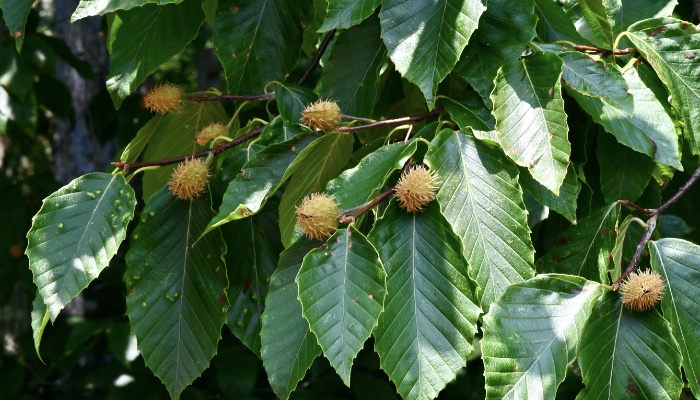
Native to North America, the beech tree is well adapted to the conditions in the Ohio Valley.
The trees can grow to 70 feet tall with thick trunks and thin gray bark that becomes rough as the tree matures.
Beechnuts or mast develop throughout the spring and summer and ripen in the fall. The triangle nuts have a bitter or nutty taste.
- Mature size: 50-70 feet
- Key identifying features: Smooth, thin gray bark and toothed, ribbed oval leaves
- Years to reach maturity: 40-60 years
- Grow Zones: 4 to 9
15. Birch
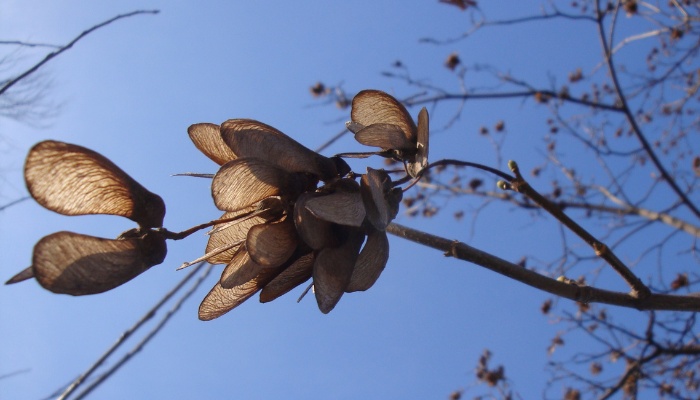
The birch is a tall and elegant tree with a somewhat dense canopy. The leaves are feather-veined, and the nuts grow in winged husks.
The nuts are oval in shape and small. It takes the birch tree about 20 years to start producing fruits.
- Mature size: 30-50 feet
- Key identifying features: Smooth, resinous, varicolored or white bark
- Years to reach maturity: 20 years
- Grow Zones: 2 to 6
Closing Thoughts
Ohio is known for its wide variety of nut trees including the Ohio buckeye, but you can find more edible nuts in the woods including hazelnuts and at least three species of hickory.
Growing nut trees takes patience as many of them take decades to start producing fruits, but planting one or more can be a worthwhile investment.
